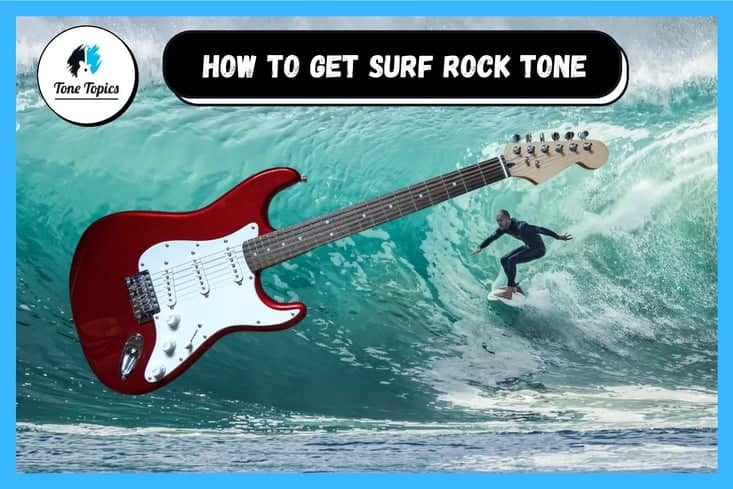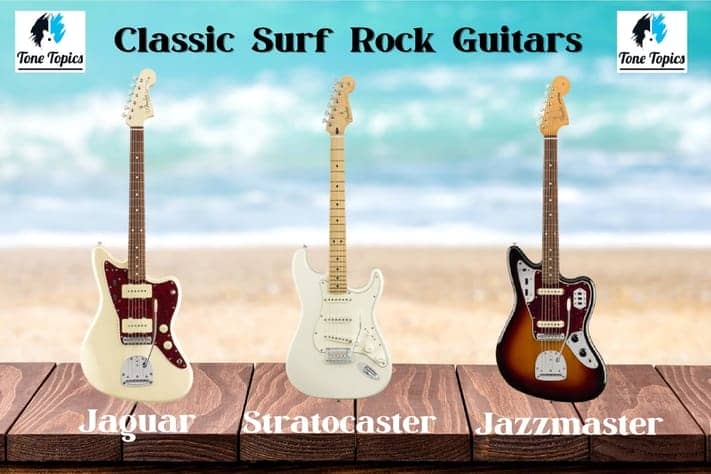
Surf rock! The sound of 1960s California.
Sun, beach, surfboards and the sound of blazing twangy Fender tones drenched in reverb.
There is quite a bit to discuss on how to capture this classic surf sound. But fear not, I decided to create this detailed post on how to do so!
This post is the ultimate guide to the foundations of the Surf Rock tone. You will learn everything from guitars, amps, effects, playing style, and much more.
Ultimately, by the end of this post, you will understand how to capture the sound and know everything about this genre that defined California in the 60s.
Sound good? Surfs up…
How to Get a Surf Rock Tone (Step by Step)
- Use a guitar with a twangy and bright sound (preferably single coils)
- Drench your sound with a ton of spring reverb
- Adopt a super clean and transparent tone from your amp with no distortion
- Use a guitar with a tremolo system for vibrato
- Use an amp with lots of clean headroom
- Use a compressor to improve your clean sound
- Use heavy gauged strings
- Use a mid to heavy gauged plectrum
- Pluck the strings close to the bridge for a twangier and piercing sound.
Video Tutorial
The History of Surf Rock
Surf Rock dates all the way back to the early rocking 60s, the surf culture in California, particularly in Southern California, gave birth to this vibrant musical movement.
In fact, Orange County was the birthplace of some of the most iconic Surf Rock acts, such as Dick Dale and His Del-Tones and the Beach Boys.
Songs were inspired by surfing, cars, beaches, girls and the shenanigans that happened during this time. Essentially, the vibrant genre was the soundtrack that defined the era of everyday beach life in the sunshine state of California.
Dick Dale and the Del-Tones were the leading act in the instrumental side of Surf Rock music, while the Beach Boys were the primary influence on this genre and popular music in general.
Unfortunately, this genre had a very short lifespan, having great popularity from 1962 to 1964, challenging another prevalent genre, Motown. But hey, it was fun while it lasted.
After 1964, Surf Rock slowly died out as more heavy types of rock and blues gained popularity. However, to this date, several artists use elements from this genre and are heavily influenced, particularly by the Beach Boys.
Defining The Surf Rock Guitar Tone
The musical ingredient that immortalized the surf-rock guitar tone was the sound of clean and piercingly thin guitar tones drenched in classic spring reverb.
This bright and twangy sound combined with fast tremolo picking and the clever use of the guitar’s tremolo bar is what gave this genre its musical stamp.
Therefore, your sound will need to emulate these ingredients in order to emulate the surf rock sound.
7 Awesome Surf Guitar Riffs (Watch Below)
Take a listen to some of these classic surf rock tracks…
Let’s Go Trippin’ – Dick Dale & the Del-Tones
Wipe Out – The Surfaris
Misirlou – Dick Dale & the Del-Tones
Surfin’ U.S.A. – The Beach Boys
Pipeline – The Chantays
Vital Surf Rock Techniques
Alternate Picking
As you may guess, this genre is predominantly based on fast guitar riffs and alternate picking. Alternate picking is the main element for you to develop if you are looking to master this style.
It becomes particularly challenging to have accuracy, speed, and stamina. Your metronome will be your best ally. Building up your alternate picking speed takes time and practice.
With lots of practice, you can build up your speed with consistency and building up your stamina and accuracy to maintain a fast and effective plucking speed.
Top Tip: pinch the plectrum with your thumb and index finger close to the bevel of the plectrum. This will increase will reducing drag and thus increasing plucking speed and efficiency.
Palm Muting
Another technique that is commonly used in surf rock is plucking strings while simultaneously muting the string with the palm of the hand. Why do this may you ask?
The reason is that muting strings dulls the sound but increases the intensity of the ‘drip’ sound of the spring reverb.
An intense spring reverb is what all surf rock guitarists go for. This technique is mainly used for riffs and picking sections.
Plucking Close to The Bridge
Another vital aspect of Surf Rock guitar is that most surf guitarists pluck the strings close to the bridge rather than the neck.
Plucking the strings closer to the bridge pickup intensifies the brightness of the tone, which is what all the surf rock guitarists go for.
Doing so promotes a twangier tone, with less bass and produces maximum brightness out of your guitar.
This technique is especially useful if you have a naturally warm sounding guitar such as a Les Paul with beefy sounding humbuckers for example.
Best Guitars for Surf Rock

Now technically, you can use any guitar surf rock. But if I was to give you recommendations…
I’ve got one word for you: Fender.
Fender guitars, Fender amps. This makes all the sense in the world since Fender is a company based in California and heavily influenced the surf rock music scene.
Naturally, because of this, single-coil guitars are your best bet to replicate the Surf Rock sound combined with the tremolo system gives it a very specific “surf-type” vibe to your sound.
Obviously, also going with the more affordable Squier versions is also a great option.
Stratocaster
Fender’s Stratocaster was Surf Rock’s primary weapon of choice. This is most likely just due to this guitar’s popularity at the time.
Nevertheless, it is essential to know that Dick Dale (also known as “The King of the Surf Guitar”) used Stratocasters for the whole of his career.
In fact, he and Leo Fender experimented a lot together with the hopes of expanding Fender’s sound. Dick Dale is one of the first to mess around with portable reverb.
Fender Stratocasters are your best choice when it comes to Surf Rock. They have a very thin and bright sound which you can alter as you please. They are also comfortable, light, and great for modifying.
Jazzmaster
Fender’s Jazzmaster has a particularly interesting story. Leo Fender designed this model hoping to appeal to the market of top-tier musicians, especially jazz guitarists.
Unfortunately for him, it was a disaster and the Jazzmaster model had very little popularity during its early years.
It was until Seattle’s Surf band the Ventures got a hit song in their cover of Johnny Smith’s “Walk Don’t Run” in 1960.
This song’s popularity greatly impulsed the Jazzmaster, as it was the guitar used on this recording. Guitarist Kathy Marshall, known as “the Queen of the Surf Guitar,” used a Jazzmaster.
A great thing about the Jazzmaster is it is a brighter sounding guitar than the Stratocaster.
Paired with its tremolo system, this guitar is another excellent choice for those looking to replicate the Surf Rock sound and have a little bit of uniqueness to their tone.
Jaguar
Fender’s Jaguar model came out right at the peak of Surf Rock in 1962.
It was the last of Fender’s 4-guitar series with by the Telecaster (1951), the Stratocaster (1954), and the Jazzmaster (1958). It’s the only model created in the 1960s.
In a way, the popularity of this model got came thanks to the overall popularity of Fender models. Fender had never released a guitar with so much versatility with different circuitry, neck lengths and sizes, etc.
As a matter of fact, Beach Boys’ very own Carl Wilson used the Jaguar as his signature model up till the mid-60s.
Unfortunately for the Jaguar, and Surf Rock music, the British Invasion in 1964 pretty much wiped out any demand for this genre and this particular model.
Other Great Guitar Choices
- Fenders Mustang model
- Fender Telecaster
- Silvertone guitars
- The Squire Paranormal Series
- Danelectro guitars
- Gretsch guitars
- Any guitar with single-coil pickups and tremolo bar
The Best Surf Rock Amplifiers
Now technically, you can create a surf rock tone with any amp.
All of them would work! This genre is based around a crystal clean tone with no distortion and soaked in spring reverb.
This is achievable with all amps. However, here’s where we start getting into technical specifics for achieving your Surf Rock guitar tone.
The best way to get a great tone is to have an amp with a bright, clear, clean sound that has a lot of “clean headroom.”
This means that you’ll want an amp that you can turn up and have it not break or fully distort. Having an amplifier that can provide a lush and solid clean tone with ample volume and minimal break-up is going to provide the solid foundations of this sound.
Some tube amps don’t allow you to control the amp’s overdrive as well, which will have the amp break the more volume you add.
However, most amps (including tube amps) give you the ability to increase the master volume without affecting the clarity of your clean sound.
In my opinion, in most cases, A tube amp has the ability to deliver a more genuine and crystal clean tone than a solid-state.
With that said, solid-state amps can also do the job and are much cheaper and more reliable without the nuisance of being tube powered.
Why Fender Amplifiers?
As I mentioned in the beginning, Fender was a crucial element in creating and developing the Surf Rock genre.
Fender amplifiers were the first to encapsulate the overall tone for the guitar. A crucial aspect of these amplifiers? Its reverb.
Most Fender amps in the 60s had built-in spring reverb units that, at the time, were pretty advanced. This was particularly true in that era, and it was something guitarists took advantage of.
By using heavy spring reverb on their guitars, Surf Rock pioneers created that unique, fully drenched, and lush tone that will forever be Surf Rock’s staple tone.
Added to this, the clarity of the Fender’s clean sound became the canvas for all surf guitarists to build their tones with.
These classic amps are suited perfectly for you to achieve a quality, vintage Surf Rock sound.
Strings for Surf Rock
When it comes to string choice, while there are no specific string gauges that stand out in this genre, there are several pointers you can reference when choosing your strings.
First off, if you notice the usual Surf Rock tone, it is pretty bassy and full. Single-coils are known for being less full than humbuckers. Therefore it would make sense to get strings with a thicker gauge.
Another thing to notice is that most Surf Rock guitar does not incorporate many bending of the strings. You would usually get thinner gauge strings to bend effortlessly. In this case, you can get away with thicker gauges.
As I said, there are no boundaries when it comes to picking the “right” strings. As it all comes down to personal preference and how the strings suit your sound and playing style.
If you were looking to optimize your gear for the ultimate surf rock sound, then I’d probably go for heavier strings with a gauge between 0.11 – 0.13.
Best Effects for Surf Rock
There are hundreds of different effect combinations to use and you can also always push the boundaries to create your unique sound. Having said this, these are some of the most used effect pedals for Surf Rock guitar:
Spring Reverb
Reverb is and will be your #1 effect when it comes to Surf Rock music. It is crucial to achieving a quality sound and was the Surf Rock guitarists’ favourite effect
As I mentioned before, back in the day guitarists would predominantly use Fender amplifiers. These amplifiers came (and still come) with analog spring reverb.
Spring reverb is your best choice when looking for a good Surf tone. However, you don’t have to purchase a Fender amp to achieve this anymore.
There are hundreds of pedals, both digital and analog, that are either isolated spring reverbs or multi-reverb.
Your best choice would be to purchase one of these so as to not break the bank and get more versatility for other genres.
Compression
Compression is not the most crucial effect of getting a Surf Rock tone, but it would immensely help you.
The reason being that this pedal helps you get cleaner tones with more dynamic consistency. This is particularly helpful with the tremolo, alternate picking technique we discussed.
What compression does is it squashes frequencies together, creating a louder and more dynamic signal. This, in turn, gives you a sound that is more balanced in volume and frequencies.
Again, this effect pedal is not a crucial one, but it doesn’t hurt to have one in your pedal arsenal.
Tremolo Effect
In Surf Rock music, guitarists tend to use guitars with tremolo systems to achieve that spacey, wavey sound they love so much
Again, thanks to technology, you don’t have to break the bank by purchasing a guitar with a tremolo system. You can always get a tremolo pedal at a much cheaper price.
Not only this, but by purchasing a good tremolo pedal, you get so much versatility to your Surf sound. You can alter the speed of the oscillation, how big is the wave that alters the sound, etc.
Overdrive
Overdrive is another effect that is not crucial to your sound but gives you a bit of a sound quality boost.
Surf Rock guitar consists of crystal clear clean sound that cuts through. AN overdrive pedal adds a little dirt to your tone for sections where you need to be heard.
By adding an overdrive pedal to your tone, you can use it as a boost for lead parts or solos. You can also use it to color your tone and give it a little more character.
Just make sure to not turn the gain/drive knob too much or your tone will become too dirty and sound more classic rock.
Delay
Delay is the last of the effects guitarists used to get their Surf Rock tone. There are a couple of ways you can use a delay pedal to your advantage
First, by using a single repeat delay with a very short repeat time (40-120ms) you give your sound an echo-like quality.
Another thing you can do is use the twin delay with very a very short time and little repeats to make great percussive sounds. Lastly, you can always just add a long-tailed delay for solos to give your sound that depth and fulness.
Famous Surf Rock Guitarists
Dick Dale
Dick Dale, also known as “The King of the Surf Guitar”, was an American guitarist born in Boston but based in California. He was one of the first pioneers of Surf Rock music and had crucial involvement in developing the sound.
He also partnered and worked closely with Leo Fender, helping him develop the overall quality of Fender’s amps and built-in reverbs. His song Miserlou is one of the most popular instrumental Surf Rock tunes.
You can hear it in places like Quentin Tarantino’s Pulp Fiction or the Black Eyed Peas hit song Pump It.
Paul Johnson & Eddie Bertrand
Paul Johnson and Eddie Bertrand were the rhythm and lead guitarists of the early and influential Surf Rock band from South Bay, The Bel-Airs.
Even though Dick Dale is credited as the main pioneer for Surf Rock music, The Bel-Airs were the first band to have a Surf Rock hit single.
Their 1961 instrumental hit Mr. Moto put them on the map as one of the first successful Surf Rock bands.
This song featured a flamenco-inspired intro and a melodic piano interlude that began to show the different influences Surf Rock would have.
Kathy Marshall
Also known as “The Queen of the Surf Guitar, ” Kathy Marshall was a 13-year old guitarist who was very involved in the Surf Rock music scene.
While she didn’t have her own band, she participated in many sessions and played with several artists such as surf legends Eddie and the Showmen, the Blazers, the Crossfires, and Dick Dale.
There is not much background on Kathy Marshall, other than the fact that she caused quite a stir during the Surf Rock era.
Carl Wilson
Even though the Beach Boys were not just limited to the Surf Rock genre, they were a crucial influence in the development of all the music coming out of California at the time.
Carl Wilson, the younger brother of bandmembers Brian and Dennis Wilson, was the lead guitarist of the Beach Boys, and his influence on guitar will be forever cherished.
